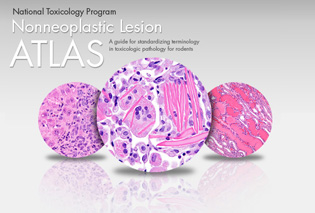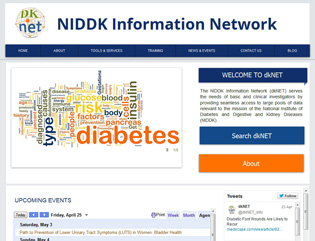News You Can Use
Nonneoplastic Lesion Atlas
A New Tool for Pathologists and Toxicologists

NATIONAL TOXICOLOGY PROGRAM, NIEHS
The NTP’s Nonneoplastic Lesion Atlas provides pathologists and other biomedical scientists access to thousands of high-quality images and guidelines for the diagnosis of nonneoplastic lesions in experimental rodent models.
Having trouble determining exactly what kind of lesion a mouse or rat has? You no longer need to hold a magnifying glass over your old hardcover textbook. Instead you can consult a new online resource—the Nonneoplastic Lesion Atlas (http://ntp.niehs.nih.gov/nnl)—to gain access to thousands of high-quality images and guidelines for the diagnosis of nonneoplastic lesions in experimental rodent models.
Developed by the National Toxicology Program (NTP), an HHS interagency program housed at the National Institute of Environmental Health Sciences (NIEHS), the atlas is a searchable Web-based guide that helps standardize lesion diagnosis, terminology, and documentation.
Nonneoplastic lesions are tissue changes that are pathological but not cancerous. Many nonneoplastic lesions occur normally with age, but they can become more pronounced when exposed to chemicals or other environmental agents. Such exposure complicates the diagnostic process; pathologists often differ in their opinions on how to describe or define particular lesions. Because many of these lesions have counterparts in NTP’s toxicity and carcinogenicity studies, the atlas is a useful resource for the entire biomedical community.
“This atlas was developed as a resource that can be used as a teaching tool and as a reference for anyone who reads [or is involved in] NTP studies,” said NTP Associate Director John Bucher. Standard guidelines that are readily available to pathologists are essential for evaluating noncancer findings in animal studies.
Currently, the atlas includes five anatomical systems—hematopoietic, or blood; hepatobiliary, which includes gall bladder and liver; integumentary, or skin; nervous; and urinary—and will eventually contain eight systems and 56 sections that each focus on a particular organ or tissue.
“Having a resource that toxicologists and pathologists all over the world can use to speak the same language when diagnosing nonneoplastic lesions in rats and mice will be invaluable to NTP and to the field,” said Robert Sills, head of the NTP Cellular and Molecular Pathology Branch. Sills conceived the atlas and worked with his team to bring the project forward.
To find out more about NTP’s Nonneoplastic Lesion Atlas, go to http://ntp.niehs.nih.gov/nnl.
One-stop Shopping for Biomedical Resources

Want a one-stop Web-based “shop” for finding biomedical resources such as data, reagents, organisms, and tools? The National Institute of Diabetes and Digestive and Kidney Diseases (NIDDK) has created one: the NIDDK Information Network (dkNET), which allows all intramural investigators to simultaneously search multiple databases that may be difficult to find using regular search engines. The information in dkNET is relevant to anyone interested in doing research on kidney, urologic, hematologic, digestive, metabolic, and endocrine diseases; diabetes; and nutrition.
“Scientists generate enormous amounts of data, but often there is no coherent means for finding it,” said NIDDK program director Ronald Margolis, who is leading the dkNET effort. “dkNET uses advanced informatics tools to establish an online ‘data-mart’ for NIDDK investigator-generated data, making [them] more readily accessible to all researchers.”
Launched in April, NIDDK–working with researchers at the University of California, San Diego (UCSD) and elsewhere–created dkNET as a catalog of NIDDK-supported online resources. dkNET contains information on some 1,900 resources, including links to such digital networks as the Nuclear Receptor Signaling Atlas, the GenitoUrinary Molecular Anatomy Project, and the Diabetic Complications Consortium.
Until recently, there has been “no good way of tracking and making collectively searchable all of the existing digital resources,” said UCSD neuroscientist Maryann Martone, who is one of the dkNET architects. She helped develop SciCrunch—a Web structure that allows researchers to cost-effectively build and share data repositories—which is now serving as the backbone for dkNET.
Sharing data and tools will enrich the research landscape in serendipitous ways, according to Margolis. “Researchers will be able to compare their data [with] already existing data and to validate their research, add to the existing store of knowledge, [and] generate new ideas.”
The site is user-friendly and easy to navigate. It includes tutorials on how to best find resources. It even has online “office hours” to answer user questions. To find out more, go to http://dknet.org.
This page was last updated on Wednesday, April 27, 2022
